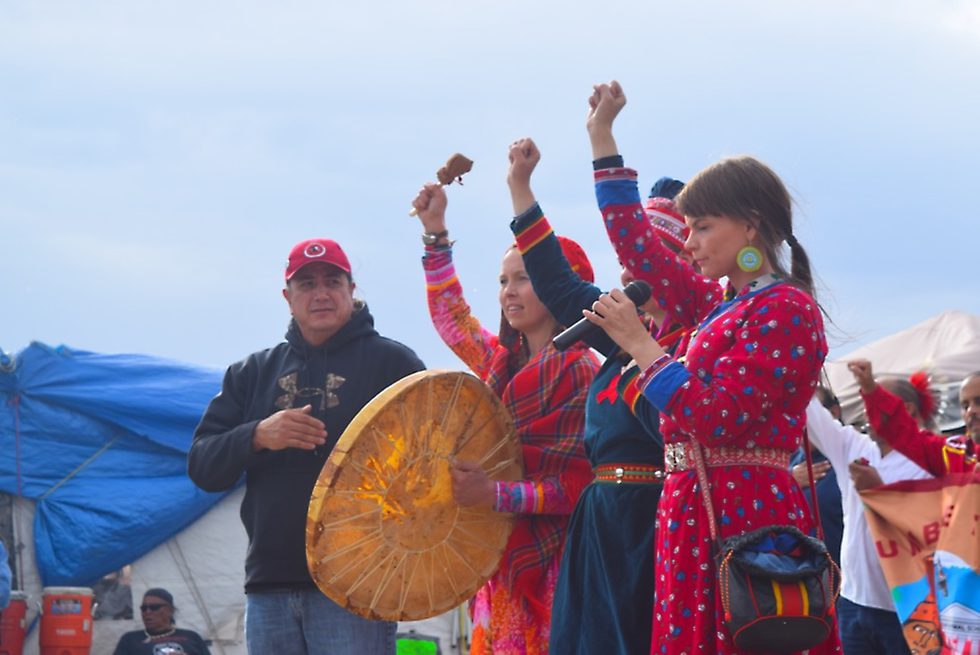
Thousands of Water Protectors from more than three hundred Native nations, as well as allied supporters from a range of social movements, gathered at the Standing Rock Sioux Indian Reservation in Cannon Ball, North Dakota during 2016 to halt the construction of the Dakota Access Pipeline (DAPL). The DAPL threatens to cross under the Mni Sose (the Missouri River), which is the fresh-water supply for millions of humans and countless nonhuman relations. By blocking settler access to capital through direct action, the enactment of political counterclaims to the land and river through ceremony and legal challenges in U.S. courts, #NoDAPL front-line protectors are directly challenging the fossil-fuel industry’s centrality in colonial accumulation and demonstrating that climate change is indelibly linked to historic and ongoing colonialism and Indigenous erasure and elimination. Contributors to this Hot Spots series consider the social, historical, cultural, and political significance of the #NoDAPL movement, situating it within Oceti Sakowin (Great Sioux Nation) history, leadership strategies and direct action/organizing, Indigenous anticolonial resistance across Turtle Island, and conditions of ongoing state violence against Indigenous bodies and lands.
The essays are accompanied by images taken by photographers Jaida Grey Eagle and Vanessa Bowen.
Anpetu wanji mni ki iyotan otehinka kte lo is a Lakota prophecy translated by her family to mean “One day, water will be more precious than anything.”
Jaida Grey Eagle is an Oglala Lakota photographer born in Pine Ridge, South Dakota and raised in Minneapolis, Minnesota. She has been photographing since she was a young child, often using disposable 35mm cameras, and she received her first digital camera at eighteen as a birthday present from her parents. Her work mainly focuses on historical events in the Indigenous community, but also includes naturally lit portraits and landscapes. Her work from Standing Rock is rooted in her concern for access to clean water and her desire to help provide coverage in the fight against environmental racism. Anpetu wanji mni ki iyotan otehinka kte lo is a Lakota prophecy translated by her family to mean “One day, water will be more precious than anything.”
Born and raised in New Mexico, a proud member of the Navajo Nation, Vanessa Bowen began creating art in childhood. Since then she has expanded her creativity from design into photography. Bowen’s project at Standing Rock seeks to capture the humanity and resilience of Water Protectors and, ultimately, to prove that our society needs to move away from fossil fuels. The photographs from Oceti Sakowin camp will be featured in her documentary Water Is Life, which aims to educate viewers about the many fossil-fuel disasters on tribal lands and about why it is essential to protect the Missouri River from the Dakota Access Pipeline.
Posts in This Series

Introduction: Standing Rock, #NoDAPL, and Mni Wiconi
Fear and uncertainty define this historical moment, but they must not guide it. Even as politicians and mainstream media attempt to normalize a bigot and racist... More

Badass (Indigenous) Women Caretake Relations: #NoDAPL, #IdleNoMore, #BlackLivesMatter
Women of the Oceti Sakowin, or the Seven Council Fires, are at the center of the movement at Standing Rock, widely dubbed #NoDAPL. Also known as Dakota, Lakota,... More

Mnisose
Mnisose, the Missouri River, is a living being. She flows from the confluence of two smaller rivers whose headwaters are in the Rocky Mountains. Her sinuous bod... More

We Are Blood Relatives: No to the DAPL
In April 2016, the Hunkpapa Titunwan established a spirit camp to protect Mni Oyate (the Water Nation) from a development project called the Dakota Access Pipel... More

Violence on the Ground, Violence Below the Ground
The actions unfolding at Standing Rock are among the most significant Indigenous mobilizations in recent memory. Since the establishment of the original Iŋyaŋ W... More

Death of Hydra
it is eel-likethe reach of corporationswho worm their way thruloophole after loopholeto take eminent domainover the landscapefor the sake of some coalor even bl... More

#DeedsNotWords: A National Day of Water Protection Solidarity North of the Medicine Line
It started with a call from the east. Cheryl Maloney, a Mi’kmaqi land defender, was watching the expansion of the resistance camp at Standing Rock. She sent a m... More

On the Violence of the Thirty Meter Telescope and the Dakota Access Pipeline
Standing Rock is a mirror of Mauna Kea: on a larger scale, but nevertheless what began with the stance and protection of Mauna Kea sparked a movement where all ... More

From Flint to Standing Rock: The Aligned Struggles of Black and Indigenous People
I recently saw one of those anecdotal Facebook posts, which intrigued me. One of my colleagues wondered whether the white presence at Standing Rock has been mor... More

“This Fight Has Become My Life and It’s Not Over”: An Interview with Zaysha Grinnell
Jaskiran Dhillon (JD): I’m here with Zaysha Grinnell, a fifteen-year-old Indigenous young woman (and a sophomore in high school) who is an enrolled member of th... More

Interrupting Industrial and Academic Extraction on Native Land
As an Indigenous scholar, I work with land defenders against the incursion of resource-extraction projects—people who are asserting their right to ways of life ... More

Standing with Standing Rock
What affects one, affects all, so we stand together united.–Nakai Clearwater Northup (Pequot youth) We are a group of scholars and cultural workers from multipl... More